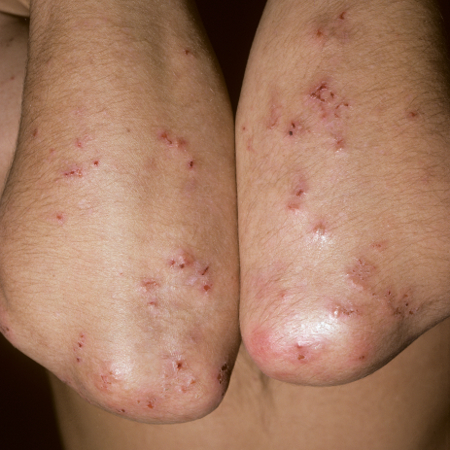Dermatitis herpetiformis (also known as Duhring's disease) presents with polymorphic, pruritic cutaneous lesions typically distributed on the elbows, knees, and buttocks. It is always associated with coeliac disease, although bowel involvement can be mild and gastrointestinal symptoms may be absent.
Diagnosis is confirmed with direct immunofluorescence microscopy. Histopathological examination and serology for the search of coeliac-specific autoantibodies, such as immunoglobulin A-tissue transglutaminase and endomysial antibody, may also be helpful but are not specific for the diagnosis of dermatitis herpetiformis.
A lifelong gluten-free diet is the treatment of choice for patients with a confirmed diagnosis of dermatitis herpetiformis. Dietary counselling is advisable in order to manage the potential issues associated with a gluten-free diet.
In case of lack of control of the disease during the first months on a gluten-free diet, dapsone is the most effective drug for the treatment of the skin lesions and control of pruritus. Ultrapotent topical corticosteroids can be considered alongside dapsone and a gluten-free diet.
Follow-up visits are helpful to assess the effectiveness and potential adverse effects of treatment, adherence to gluten-free diet, and occurrence of potential complications or associated diseases.
Dermatitis herpetiformis is a rare inflammatory skin disease that is considered to be the specific cutaneous manifestation of coeliac disease. Accordingly, dermatitis herpetiformis occurs in genetically predisposed individuals having human leukocyte antigen (HLA)-DQ2 or HLA-DQ8 haplotypes after the ingestion of gluten.[1]Antiga E, Maglie R, Quintarelli L, et al. Dermatitis herpetiformis: novel perspectives. Front Immunol. 2019 Jun 11:10:1290.
https://www.frontiersin.org/articles/10.3389/fimmu.2019.01290/full
http://www.ncbi.nlm.nih.gov/pubmed/31244841?tool=bestpractice.com
Gluten induces the development of an autoimmune response with the deposition of immunoglobulin A (IgA) at the basement membrane zone, which is considered the pathogenetic hallmark of the disease and represents the major criterion for the diagnosis of dermatitis herpetiformis.[2]Görög A, Antiga E, Caproni M, et al. S2k guidelines (consensus statement) for diagnosis and therapy of dermatitis herpetiformis initiated by the European Academy of Dermatology and Venereology (EADV). J Eur Acad Dermatol Venereol. 2021 Jun;35(6):1251-77.
https://onlinelibrary.wiley.com/doi/10.1111/jdv.17183
http://www.ncbi.nlm.nih.gov/pubmed/34004067?tool=bestpractice.com
Patients usually present with symmetric polymorphic lesions involving the extensor aspects of upper and lower limbs as well as the sacral and buttock area; pruritus is the major symptom of the disease and is invariably present in all patients. For the majority of patients, the disease is lifelong with varying periods of activity, which may be due to varying degrees of dietary adherence.[3]Ludvigsson JF, Bai JC, Biagi F, et al. Diagnosis and management of adult coeliac disease: guidelines from the British Society of Gastroenterology. Gut. 2014 Aug;63(8):1210-28.
https://gut.bmj.com/content/63/8/1210.long
http://www.ncbi.nlm.nih.gov/pubmed/24917550?tool=bestpractice.com
